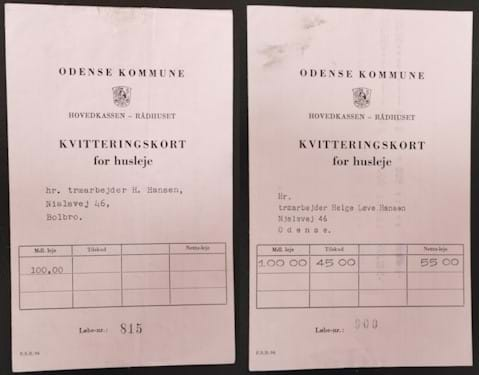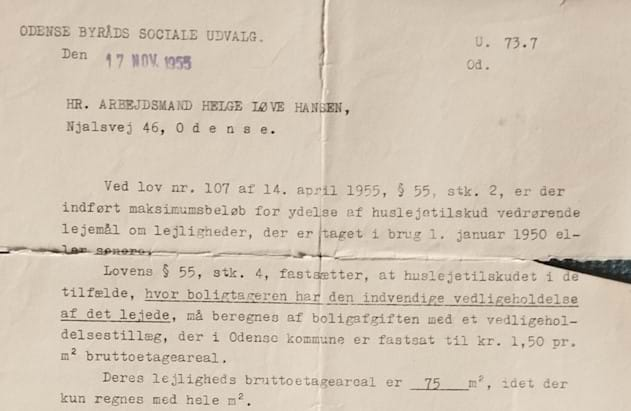My grandmother Jenny Kirstine Juhl (1921-2008) and my grandfather Helge Løve Hansen (1915-76) had their first home on Nørregade in downtown Odense, but they didn't stay there for long. My mother has told me that they moved to the suburb Bolbro when she was 4 years old. They were four sisters, and they were transported on the trailer of a svajercykel (a type of cargo bike). My grandfather's father, Ludvig Hansen (1885-1968), began working as a svajer (a peddler who goes by bike) around that time, so perhaps it was his bike. It was similar to the one in the photo below.1

The family moved from the first floor in the second rear courtyard of Nørregade no. 53 in downtown Odense to Njalsvej no. 46 in Bolbro on 1 September 1954. It wasn't possible to report the move online back then. It had to be done on paper, and either my grandmother or grandfather delivered the notice themselves to get a receipt to confirm that it was done on time. They also paid a deposit of 400 kroner.
My grandfather had signed the lease contract almost three weeks earlier, so they were busy packing up their things. My mother remembers that she wasn't allowed to bring her pedal car. The new tenants were allowed to have it for their child. My mother wasn't entirely happy about that, but that's the way it was.
The image at the top shows a collage with the change of address notification on the left (seemingly filled in by my grandmother) and the deposit bill and part of the lease contract on the right.
Njalsvej 46 is a terraced house in a relatively large residential area called Saxoparken. My grandmother and grandfather lived there for the rest of their lives. I never met my grandfather, but I have visited my grandmother there many times. It must have been nice for my grandmother not to have to go up and down the stairs with four children and laundry anymore – and suddenly to have a garden.

The rent was 100 kroner per month, but the receipts show that my grandfather received a subsidy of 45 kroner each month from April 1955. The image above shows the cover of the receipt cards from 1954 and 1955. My grandmother rarely threw paperwork away, and of course, she kept the letter explaining the subsidy. They were entitled to a subsidy under a law passed on 14 April 1955. That explains why they didn't receive the subsidy in 1954.

Imagine getting a subsidy of 45 percent of the rent! My grandmother grew up in the countryside, attended a home economics school, and worked as a house assistant in private homes, a children's home, and a hotel, so she undoubtedly knew how to make ends meet. However, it must still have meant a lot for their financial situation to have nearly half of the rent covered by the subsidy.
Perhaps it's a bit much to expect our ancestors to keep bill, receipts, and similar documents from several decades, but it's fun to examine the papers now that they have been preserved. I'm glad we didn't throw everything away after we lost my grandmother, or else I wouldn't have had these details for my family history. My husband will probably be happier when I've scanned all the papers and gotten rid of them. They take up quite a bit of space. But don't worry – the papers won't go in the trash if others are interested in them, for example, the local archive.
Source reference:
1. "Sct. Peders Stræde 10," copy of a photograph, kbhbilleder.dk (https://kbhbilleder.dk/kbh-arkiv/85911 : accessed 9 April 2024); citing original by photographer Mogens Falk-Sørensen, 1960, held by the Copenhagen City Archives.




